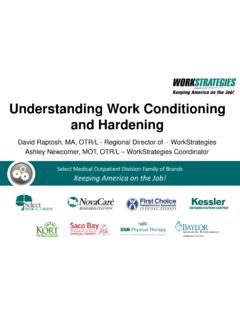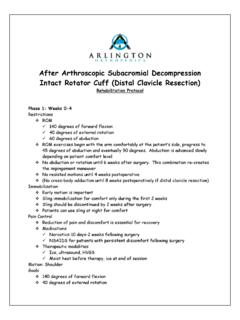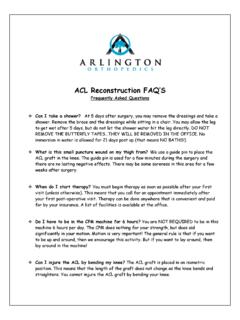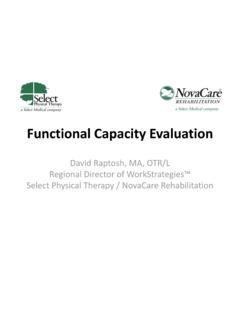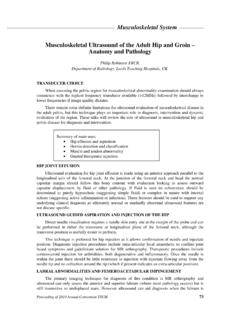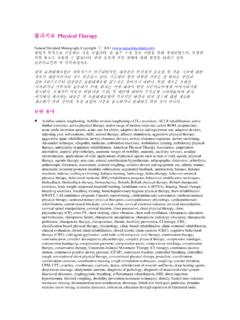Transcription of Return to Work after a Concussion or TBI
1 Return to work after a Concussion or TBI: Ned Crane, DPT, DAC McNamee, S., et al, Minimizing the effect of TBI-related physical sequelae on vocational Return , JRRD Volume 46 Number 6, 2009 Pages 893 908 Traumatic brain injury (TBI) is a leading cause of worldwide disability, with one estimate showing a loss of 56 billion dollars in economic productivity Vocational Return is regarded as the most durable sign of successful community Return Employment becomes a challenging, if not unlikely, feat to attain because of a myriad of cognitive, physical, and psychosocial problems. Meaningful productive employment enhances self-esteem, financial status, and one's overall quality of life, Furthermore, vocational Return is increasingly viewed as a means of enhancing cognitive, behavioral, and physical recovery after the acute rehabilitation phase.
2 Because of this and other factors, vocational rehabilitation strategies to assist survivors of TBI are of utmost importance. Dealing with Dizziness Posttraumatic dizziness affects 20 to 65 percent of patients with TBI [ and remains disabling for many months Dizziness is among the top five postconcussive symptoms distinguishing patients with mild TBI from healthy controls One study showed a 46 percent failure of RTW 5 years after mild to moderate TBI for patients with posttraumatic dizziness. A more recent study on RTW at 6 months post-injury (mild and moderate) showed 34 percent of individuals with dizziness were gainfully employed compared with nearly 75 percent of subjects without dizziness.]
3 Importantly, dizziness was also associated with increased psychological distress (including anxiety and depression), which may further hinder RTW efforts Studies of patients with dizziness after mild to moderate TBI show a rate of vestibular abnormalities between 32 and 65 percent. The large number of patients with dizziness who do not have objective findings of neural damage reinforces the connection with psychological factors. Medication-based treatments, such as the anxiolytic agents buspirone or trazodone, may be aimed at these psychological factors and can have positive effects on symptoms. Commonly prescribed "sedating" medications, such as meclizine, are controversial in that their mechanism of decreasing the sensation of causative stimuli can theoretically slow recovery.
4 Focused vestibular rehabilitation programs with purposeful exposure, habituation, and coping strategies have proven efficacy. Benign paroxysmal positional vertigo is a condition that is caused by movement of otolithic debris or granules within the semicircular canals. Trauma can lead to the release of such debris. Specific therapies (Dix-Hallpike maneuver and Liberatory technique) can be used for both diagnosis and therapy. Even in the face of disabling dizziness, progressive Return to activity, including driving and work , is key Reducing symptoms preventing habituation to abnormal movement patterns ( ., remaining lying down for activities) This "forced" activity is a necessary component of the rehabilitation efforts for vertigo.
5 Intensive vocational rehabilitation services are indicated and invaluable in the early rehabilitation course . work site modifications and job accommodations are initially an integral aspect of vocational rehabilitation can usually be tapered away as the symptoms and tolerance improve. Gradated exposure to the necessary aspects of the job ( ., repeated movements, visual distractions) is both therapeutic and facilitates RTW efforts. Medications, while occasionally helpful early in the treatment program, are limited in the work setting because of cognitive depression. Dealing with Vision Reports of visual changes (usually worsened visual acuity) occur in up to 20 to 40 percent of individuals with TBI True deficits in vision are difficult to differentiate from visual perceptual deficits (the brain's interpretation of what the eyes see) True field cuts ( , homonymous hemianopsia, quadrantonopsia, tunnel vision) are more common in ischemic damage to the brain but may also be seen with traumatic injuries Cortical blindness (Anton's syndrome) may be seen following occipital lobe injury but is uncommon The Useful Field of View (UFOV)
6 Test is a measure of the functional or useful range of peripheral vision under cognitive load conditions As cognitive load is increased by elevating task complexity, the functional range of peripheral vision ( , the degree of peripheral vision from which information is processed) becomes restricted Thus, the functional extent of peripheral vision under complex real-world conditions, such as detecting stimuli in cluttered backgrounds, is not always equivalent to the maximum extent of peripheral vision that can be measured with clinical perimetry techniques Individuals with TBI, strokes and older adults often have impaired UFOV Survivors with TBI exhibited decreased information processing time and mild impairment at all eccentricities, with the greatest impairment on the selective attention subtest of the UFOV.
7 These findings suggest that survivors with TBI may need more time to locate stimuli in cluttered backgrounds and are less accurate than people without brain impairment. These results are consistent with previous reports of higher errors and task completion times on cancellation tests involving visual search. rehabilitation efforts for visual deficits focus on enriching the environments to increase appropriate stimuli to the areas of visual decline. This strategy should be applied both in the structured therapy setting and in the general treatment milieu. In addition to enhancing visual stimuli and specialized interventions, rehabilitation efforts must also focus on enhancing the cognitive functioning.
8 The use of these strategies and devices allows for greater adaptation to deficits and greater use of other senses. Many of the tactics used for newly blind individuals (from any cause) are used in a modified way for individuals with TBI. Studies have demonstrated poorer overall functional outcomes with persistent visual deficits and poorer RTW with visual perceptual deficits after TBI. Vocational efforts for individuals who have visual deficits that are of clinical significance are typically introduced once an individual has returned to the community. Transportation to the work site may present significant challenges and must be addressed early in the course.
9 Unique aspects of "blind rehabilitation " that are relevant to the individual with TBI are the overlying cognitive, behavioral, and physical impairments commonly seen. Safety concerns must be emphasized in individuals with TBI and impaired sight because of the decreased sensory feedback and, not uncommonly, decreased safety judgment. Dealing with Headaches Pain is commonplace after TBI of all severity levels. In a study of hospitalized patients with TBI, 71 percent required narcotic pain medication prescription upon discharge In an adult tertiary care pain clinic investigation, 58 percent of persons with mild and 52 percent with moderate to severe TBI reported chronic pain.
10 Chronic pain is usually defined as 6 contiguous months of pain and is often intertwined with psychopathology and environmental factors In its persistent form, chronic pain typically imposes severe emotional, physical, economic, and social stresses on the patient and family. after major trauma, potential etiologies of pain are numerous. The anatomical source of pain in individuals after TBI may be intracranial or extracranial, depending on the pattern of trauma. Proper detection and diagnosis of pain is paramount for achieving optimal rehabilitation potential after TBI. With proper evaluation, pain can often be classified into one of the following clinical types: Musculoskeletal Vascular Visceral Neural tissue origin Headache (HA) is the most frequent pain reported after TBI, with a prevalence range from 18 to 93 percent depending on study methodologies.
